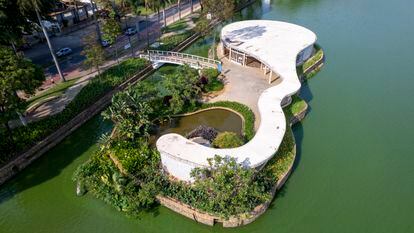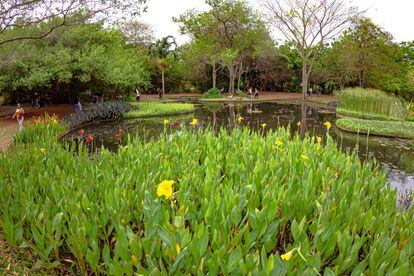Despite being the country with the greatest diversity of flora on the planet – it has 50,000 species – Brazil's native plant wealth was for years reviled by its upper class. At the beginning of the 20th century, Brazilian gardens imitated European landscaping and plants were imported from the old continent. While native species were considered weeds, the elite grew roses and geraniums and kept hedges impeccably trimmed as a sign of status.
In 1928, a very young Roberto Burle Marx traveled from his native Brazil to Germany. During his stay to treat his vision problems, he studied music and painting, attended opera and theater, visited museums and art galleries, and came into contact with the work of avant-garde European artists such as Van Gogh, Picasso, and Paul Klee. . In one of his life notes classes he visited the Dahlem Botanical Garden in Berlin, one of the first to incorporate the fashion of hot stoves to acclimatize tropical species. It was like this, under the German greenhouses, brush in hand, where Burle Marx discovered his fascination with Brazilian flora, barely known to him, despite his love of gardening since he was a child. Years later, he would be a pioneer in introducing native plants into garden design in Brazil, thus ending decades of plant snobbery.
Upon returning to his country in 1930, Marx enrolled in the Escola Nacional de Belas Artes in Rio, directed by the man who would end up being his mentor, Lucio Costa. The architect lived on the same street as the Burle Marx family and knew the family garden tended by Roberto. In 1932 he proposed that she take charge of his first project as a landscaper: the garden of the Schwartz House.
Burle Marx's first important commission was the garden of the Ministry of Education and Health in Rio de Janeiro (1938), a project that gave him the opportunity to collaborate with Le Corbusier and Oscar Niemeyer, with whom he would end up forging a fruitful bond. On the roofs of the building, he created a sinuous pattern of amoeboid spots to be seen from the upper floors. This organic movement, together with the vindication of native species, represented a groundbreaking milestone in Brazilian landscaping that announced the concept of the modern tropical garden.

Gardens on canvas
The layout of Burle Marx's gardens reveals his affinity for abstract art, particularly the work of Arp, Calder, Léger and Miró. The recognizable planes of it are true works of art in themselves. This is how the Museum of Modern Art in New York wanted to celebrate in 1991, with an individual exhibition on the Brazilian's work that, still today, is the only one that MoMA has dedicated to a landscape painter.
Interest in nature permeates all the art forms that Burle Marx cultivated. Although history recognizes him as the most influential landscape painter in Brazil, he was an outstanding multidisciplinary artist: he painted on canvas, wove tapestries, made engravings, tiles, sculptures and jewelry. Color, light and texture, as well as organic shapes, were essential in all the techniques and supports with which he experimented. Burle Marx himself considered himself primarily a painter, as he himself acknowledged: “Landscaping is nothing more than the method I have found to organize and compose my drawings and paintings, using less conventional materials.”
In his 60-year career, in which he designed nearly 3,000 gardens (not all of them were executed), in addition to numerous residential projects, Burle Marx devised a huge number of parks and public squares. In 1943, Oscar Niemeyer invited him to intervene in his new complex of social and cultural buildings in Pampulha. The architectural complex, arranged around a large artificial lake and dotted with gardens, is today a World Heritage Site.. This would be followed in 1953 by his design for Ibirapuera Park in São Paulo, a succession of 14 gardens (which were ultimately not carried out) in dialogue with Niemeyer's exhibition buildings.

Tropical activism
His work in the Araxá Park (1943), in the state of Minas Gerais, allowed him to collaborate with the botanist Henrique Lahmeyer de Mello Barreto. The work with Barreto was decisive in Burle Marx's career. Together they made multiple collecting expeditions throughout the state, in order to study the plants in their place of origin before applying them to their projects. From then on, his botanical travels throughout Brazil did not cease. During 40 years of study he discovered 37 hitherto unidentified species that are now very common in gardens and interiors. Many of them include the Latinized name of their discoverer in their scientific name: scoff marxii.
“These mysteries, these forces of nature, are my gods. When I no longer have the curiosity to pursue them, I will surely die,” declared Burle Marx in an interview with Los Angeles Times in 1969. His efforts to celebrate the exuberance of Brazilian flora turned biodiversity into a key element of Brazil's modernity. However, the incorporation of these species into his projects was not easy. Previously he had to grow species in his own nurseries that at that time were only found in the jungle.
His activism did not prevent him from designing gardens for residential buildings and luxury homes with Rino Levi, for public social housing complexes with Eduardo Kneese de Mello and with Affonso Eduardo Reidy, for the famous residential complex do Pedregulho in Rio de Janeiro (1951). The Burle Marx – Reidy tandem in Rio reached its culmination with the geometric gardens for the Museum of Modern Art in 1956 and the Flamengo Park (1965).

The waves of Copacabana
Perhaps the most mainstream by Burle Marx is his intervention in the Paseo de Copacabana (1970) together with the architect Haruyoshi Ono and the landscape designer Jose Tabacow. The four kilometers of undulating pavement that run along Rio's Atlantic Avenue, parallel to the mythical Copacabana beach, are one of the most iconic postcards of the city and the main recreation area for Rio society. Here, the landscaper put pedestrians first to the detriment of cars and even vegetation. Much of the surface of this walk is covered in mosaics. In addition to the famous cobblestones, inspired by Portuguese urbanism, on the other side of the asphalt extends an abstract composition designed by Burle Marx.
A decade later, he would conceive one of the most representative projects of his style: the Fazenda Vargem Grande. In this former coffee-producing hacienda, Burle Marx took advantage of the existing terraces, irrigation canals and retaining walls to create a garden where water is the central element of the design.
Although most of his gardens were built in Brazil, his work also crossed borders and can be seen in Venezuela, in the Parque del Este in Caracas and the Botanical Garden of Maracaibo or in Paris, in the courtyards of the UNESCO headquarters. After the demolition of his project for Biscayne Boulevard in Miami, the only work of Burle Marx that survives in the United States is the Cascade Garden in Longwood Gardens, Pennsylvania.

The Roberto Burle Marx Site
“I have already decided the place of my grave: in the Site, under a leafy tree. “I want to become a tree where every finger will have a beautiful bloom and I will feel the wind, the storm and the lightning lighting me up.” This is how Burle Marx referred to the farm where the artist spent the last 20 years of his life. An extension of 60 hectares in Barra de Guaratiba, on the outskirts of Rio, which ended up becoming his experimental garden and his most personal work.
In Siege, Burle Marx received visits from Le Corbusier, Frank Lloyd Wright and Walter Gropius; but there, above all, he gathered an extraordinary botanical collection of more than 3,500 species of tropical plants collected on his expeditions throughout Brazil. This landscape laboratory houses the most representative sample of native Brazilian plants, along with numerous rare specimens of tropical flora from India, the Philippines or South Africa. Among the exuberance, its collections of bromeliads, heliconias, orchids, amaryllis, alocasias, palm trees and water lilies stand out.
“I am simply a plant collector,” Burle Marx repeated. Here he studied the behavior and potential of species that he would later apply in gardens. Site was also the headquarters of his prophetic cause against the agricultural destruction of the tropical habitats of his homeland. 30 years after his death, Burle Marx's life project is today a UNESCO World Heritage Site.

#plant #snobbery #Burle #Marx #introduced #modernity #Brazilian #garden

Leave a Reply